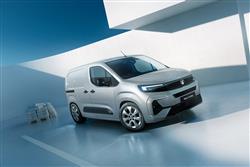SPACE CADET (some text hidden) --NONE--
By Jonathan Crouch
Vauxhall's Combo is a panel van with the one thing operators really need: serious carrying capacity of up to 4.4m3. Jonathan Crouch drives the improved fourth generation version.
Ten Second Reviewword count: 68
Vauxhall has usefully improved its fourth generation Combo with a smarter look, a more modern cabin and extra range for the EV version. As before, it's a very class-competitive compact van, with both short and long wheelbase body styles that together should be able to satisfy almost every buyer in this segment. With frugal running costs, smart design and strong practicality, it's everything a small LCV should be.
Backgroundword count: 172
Identity. We all have it. But certain vehicles often don't, particularly if they're vans designed on a shared platform. One such is the Vauxhall Combo, which over the years has been based around first General Motors, then Fiat engineering, but which since 2019 has shared almost everything with the Peugeot and Citroen vans it primarily competes against, as well as models from Fiat and Toyota. In designing the original version of this current fourth generation Combo, Vauxhall was allowed very little latitude in giving this LCV its own distinct look - but that changed in late 2023 as part of the update that created the version of it we're going to examine here. Which is just as well because the other changes made are the same as you'll find in the other four van models that share this one's design - the Peugeot Partner, the Citroen Berlingo, the Fiat Doblo and the Toyota Proace City. Namely improved cabin infotainment and a longer range for the electric version. Let's take a closer look.
Driving Experienceword count: 245
The Combo's diesel powerplants are as before, a 1.5-litre unit with 100 or 130PS. The units are combined with five and six-speed manual transmissions. In addition, a low-friction eight-speed automatic with Quickshift technology can be ordered in combination with the top-of-the-range 1.5-litre 130PS diesel. As for refinement, well, the slightly clattery note at start-up settles down quite acceptably once you get up to speed. There are powertrain differences with the electric version. Battery changes have been made here, but surprisingly they don't include installation of the latest 54kWh battery that the Stellantis Group is currently rolling out amongst its electric cars. Instead, the existing 50kWh pack has been revised to give 30 miles more driving range - now rated at 205 miles. A heat pump is now fitted as standard, so you'll be able to sustain most of that in really cold conditions. As before, the electric motor offers 136PS with 270Nm of torque. And there are three levels of brake regeneration, accessible via steering wheel paddles. Whichever body shape you choose - standard or long - you'll find that the driving position pretty good, with the steeply raked windscreen and low bonnet combining to give great visibility. Couple that with big panoramic door mirrors and the result is a vehicle you can be confident about driving even the most congested city streets where the light steering facilitates a tight turning circle, 11.2m in the short wheelbase version and 12.5m for the long wheelbase model.
To see the full road test text contact us on 0330 0020 227
Pictures (high res disabled)
.jpg)
.jpg)
|
.jpg)
|
.jpg)
| |||
.jpg)
|

|
Statistics (subset of data only)
Min |
Max |
|
Price: |
£20,850.00 (At 15 Dec 2023, ex-VAT) |
|
Load Volume (l): |
2 |
4 |
Payload Capacity (l): |
750 |
1000 |
Scoring (subset of scores)
Category: Vans
| Performance | |
| Handling | |
| Comfort | |
| Space | |
| Styling, Build, Value, Equipment, Depreciation, Handling, Insurance and Total scores are available with our full data feed. | |



